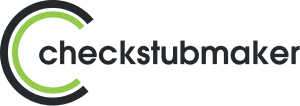Is a pay stub a check? This is a common question many employees ask when trying to decipher their money-related paperwork. At Check Stub Maker, we’re here to clear up any confusion.
A pay stub isn’t the same thing as a check. Unlike a paycheck which mostly states what you’ve earned during a specific pay period, a pay stub goes further in detail.
Paystubs break down your entire earnings into important elements such as contributions made to health insurance or retirement annuities, how much you’ve been taxed by the federal government, and any other income you’ve earned such as overtime or garnishments.
As experts in the payroll process, we can help you understand the nuances between these two pertinent documents and the overall significance of check stubs meaning.
In this blog post, we’ll explore whether a paycheck is the same as a pay stub, how to read both sets of financial data, and provide an example of a paycheck to further illustrate their key differences.
What this article covers:
- Is a Paycheck the Same Thing as a Pay Stub?
- How to Read a Paycheck or Pay Stub
- Example of a Paycheck
Is a Paycheck the Same Thing as a Pay Stub?
After conducting experiments with it, we at Check Stub Maker can confidently say that a paycheck isn’t the same as a pay stub.
A paycheck is a physical or electronic payment issued by an employer to an employee for services rendered. It typically includes the total amount of money earned during a specific pay period, minus any deductions.

On the other hand, a pay stub, also known as a payslip or earnings statement, is a document that offers a detailed breakdown of an employee’s pay. It usually includes information about your gross wages, deductions, and net pay.
As such, the check stub serves as a record of payment, giving necessary transparency and insight into how an employee’s income was calculated.
Some key differences between the two types of paperwork is that you might receive a paycheck with the paycheck stub attached.
Alternatively, you may receive pay stubs digitally and separately from your paycheck through your employer’s payroll portal or through the bank, particularly if you receive your salary via direct deposit.
This is all dependent on your employer and what laws govern employment and payment processes in your specific state.
How to Read a Paycheck or Pay Stub
Here at Check Stub Maker, we’ll break down how to read both a paycheck and a pay stub to help you better understand your income.
How To Read A Paycheck
Based on our observations, a paycheck generally contains the following information:
- employee’s name and address
- employer’s name and address
- check number
- pay date
- pay period
- net pay amount
The most significant part of a paycheck is the net pay amount – the sum you actually receive from your employer. This figure represents your gross pay minus all deductions such as taxes, insurance premiums, and retirement contributions.

How To Read A Pay Stub
If you’re wondering, “What do check stubs look like?”, they generally contain more detailed information than paychecks.
Here’s what you’ll typically find on a pay stub:
- Gross Pay: The gross pay is the total amount you earn before any deductions, including your base salary, overtime, and bonuses.
- Net Pay: Unlike your gross pay, the net pay is the actual amount you receive after deductions like taxes, Social Security, and other withholdings have been made by your employer.
- Regular And Overtime Hours Worked: This section of your pay stub shows the total hours you’ve worked during the pay period. They’re generally separated into regular and overtime hours. Overtime is often paid at a higher rate to compensate you for any additional work you do.
- Pay Rate: The pay rate is the hourly or salaried rate that you’re paid for regular hours and any additional overtime hours you’ve worked.
- Taxes Withheld: The taxes your employer usually withholds from your paycheck include federal, state, and local. The final amount depends on your income, filing status, and the state you work in.
- Social Security And Medicare Contributions: Social Security and Medicare contributions are mandatory deductions taken from your paycheck that contribute to the Social Security and Medicare programs.
- Insurance Premiums: Insurance premiums are deductions that specifically go towards employer-sponsored programs such as health, dental, or life insurance.
- Retirement Plan Contributions: Unlike mandatory deductions, contributions typically made to retirement plans like a 401(k), for instance, are often voluntary and tax-deferred.
- Year-To-Date Totals For All Categories: The Year-To-End-Date (YTD) totals on your paycheck and pay stub represent the cumulative amount of your earnings, taxes, and deductions up to the current pay period.
Pay stubs provide a comprehensive view of your wages and deductions. They allow you to verify that you’re being paid correctly and that the proper amounts are being withheld for taxes and other pertinent purposes by your employer.

Example of a Paycheck
To illustrate the difference between a paycheck and a pay stub, let’s look at an example of a conventional paycheck:
Paycheck Example:
——————————————————————————————————————————————–
Employer Information
Company Name: XYZ Corporation
Address: 123 Main Street, Cityville, ST 12345
Employee Information
Name: John Doe
Pay Period: 08/01/2024 – 08/15/2024
Employee ID: 12345
Check Number: 789654
Pay Date: 08/16/2024
——————————————————————————————————————————————–
Earnings
Gross Pay: $2,500.00 (80 regular hours at $25/hour)
Deductions
- Federal Tax Withheld: $350.00
- State Tax Withheld: $100.00
- Social Security (6.2%): $155.00
- Medicare (1.45%): $36.25
- Health Insurance Premium: $50.00
- 401(k) Contribution (5%): $125.00
——————————————————————————————————————————————–
Net Pay: $1,683.75
——————————————————————————————————————————————–
Year-To-Date Totals
Gross Earnings: $20,000.00
Total Deductions: $4,500.00
Net Pay: $15,500.00
——————————————————————————————————————————————–
In this example, you can see that a paycheck contains important elements, such as:
- the employee’s name and address
- the employer’s name and address
- the check number (usually in the top right corner)
- the pay date (the date the check is issued)
- the net pay amount
Notice that while the paycheck shows the final amount you’ll receive during a given pay period, it doesn’t supply you with a detailed breakdown of how that amount was calculated.
That’s where learning how to make paystubs is helpful. Our findings at Check Stub Maker show that our digital pay stubs can assist you with curating a comprehensive overview of your gross pay, deductions, and net pay.
Conclusion
In this blog post, we discovered that a pay stub isn’t the same as a check, although they’re closely related.
We explored the differences between paychecks and pay stubs, learned how to read both documents, and finally evaluated an example of a traditional paycheck.
Understanding this payroll paperwork is critical for managing your finances and ensuring you’re being compensated correctly by your employer.
If you’re a small to medium-sized business owner looking to generate professional and accurate pay stubs for your employees, we invite you to try our user-friendly pay stub creator.
At Check Stub Maker, we make money matters smooth and hassle-free for businesses of all sizes!
Did our blog meet your needs? You might also find our other guides helpful:
- How Can I Get a Copy of My Pay Stub If I Am a Teacher?
- How to Get a Pay Stub As a Waitress
- Where Can I Find a Pay Stub for My Veterans Disability?
- What Is STD on Paystub?
- What Is RSU Offset on Paystub?
- What Is ESPP on Paystub?
- What Is EIT on Paystub?
- What Is EWW on a Paystub?
- What Does PTO Stand for on a Pay Stub?
- What K Stands for in Pay Stubs
- What Does SERS Stand for on a Pay Stub?
- What Does TRS Stand for on Paystub?
- What If I Don’t Have Pay Stubs?
- How Do I Get My Check Stubs If My Paycheck Is Deposited Automatically?
- How to Get a Paycheck Stub If You Work Under the Table




